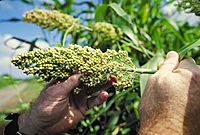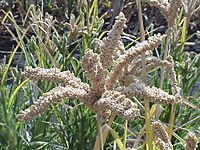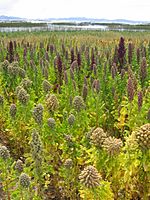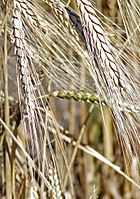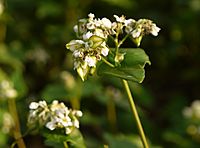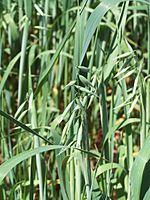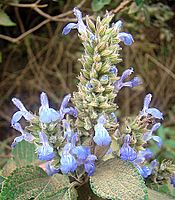Ancient grains facts for kids
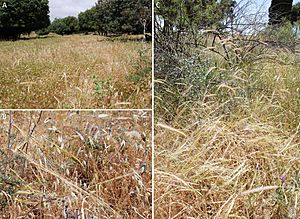
Ancient grains are types of grains and pseudocereals that haven't changed much over thousands of years. They are different from common grains like corn, rice, and modern wheat. These common grains have been changed a lot by people choosing the best plants to grow.
Ancient grains are often said to be healthier than modern grains. However, some experts disagree about how much better they are for you.
Some popular ancient grains include:
- Wheat types: spelt, Khorasan wheat (Kamut), einkorn, and emmer.
- Other grains: millet, barley, teff, oats, and sorghum.
- Pseudocereals: quinoa, amaranth, buckwheat, and chia.
Even though they are called "ancient," modern wheat actually comes from three ancient wheat types: spelt, einkorn, and emmer.
Contents
History of Ancient Grains
The story of grains began about 10,000 years ago. This time was called the Neolithic Revolution. During this period, people started to change from hunter-gatherers to farmers.
Modern grains have been changed over time through different methods. These include natural changes, careful planting, and scientific research. But ancient grains are thought to be very similar to their first wild versions.
Scientists have found old evidence of grains from ancient times. This evidence includes burnt grains and grain marks on old pottery. These findings help us learn about how people used grains long ago.
Ancient grains were important in the spiritual lives of many old civilizations. The Aztecs, Greeks, and Egyptians all used them. For example, the Inca people called Quinoa the "mother of all grains." They thought it was sacred.
The Aztecs also saw amaranth as sacred. They used it in religious events. Because of this, Spanish rulers later banned its growth. Some ancient grains are even mentioned in the Old Testament.
People started talking about ancient grains as a health food in 1996. Since then, they have become much more popular. By 2011, the market for gluten-free foods, which includes many ancient grains, was worth $1.6 billion.
Types of Ancient Grains
Ancient Wheat Varieties
Studies of old plants show that three types of wheat existed long ago. These were Triticum sphaerococcum, Triticum vulgare, and Triticum compactum. The first two types are still grown today, mostly in Northern India.
Two very early wheat types are einkorn and emmer. Evidence of einkorn and emmer has been found from around 7500 BC to 6500 BC. These findings came from places like Ali Kosh in Iran. Triticum durum Desf might have been grown in Ancient Egypt.
Some ancient grains found in India include:
- Triticum sphaerococcum (Indian Short Wheat): This is the earliest known cultivated wheat from India. It was found at sites like Harappa.
- Triticum vulgare (Bread wheat): Evidence for this wheat was found at Chanhudaro and Mohenjodaro.
- Triticum compactum: Found at Harappa and Mohenjodaro.
Barley as an Ancient Grain
Barley (Hordeum) is one of the oldest crops grown by humans. It was widely grown in the Near East and Southern Europe. The first domesticated barley might have come from places like Beidha.
Ancient barley has been found at sites like Çatal Hüyük (around 5850 BCE). In India, barley was mostly grown in the northern and central areas.
Ancient Rice Cultivation
Rice is believed to have been grown in Thailand since 3500 BC. Scientists found marks of rice grains on old pottery there. Other places where rice was grown include Neolithic sites in China.
Wild Rice
Wild rice is not directly related to the rice we usually eat. It has almost twice the fiber of regular rice. It also contains about 15% protein and healthy fats like omega-3 and omega-6 fatty acids.
Native American groups like the Anishinaabe harvested wild rice long ago in North America. Archaeologists have found evidence of them preparing this plant.
Millets: A Diverse Group
The origin of finger millet (also called ragi) is debated. Some think it came from Africa, others from India. Burnt grains of both wild and cultivated ragi have been found in southern India.
Pearl millet was grown in dry areas. Evidence of it has been found in India and Africa. In modern India, pearl millet (called bajra) is still mostly grown in dry regions.
Other millets like Paspalum scrobiculatum (Kodo millet) have been found in India. Sorghum vulgare is known from dry parts of Rajasthan and Maharashtra.
Nutritional Benefits of Ancient Grains
People who support ancient grains say they are rich in protein, omega-3 fatty acids, and antioxidants. Antioxidants help protect your body's cells.
However, some nutritionists say that ancient grains are not necessarily healthier than modern grains. They believe that both ancient and modern grains offer similar health benefits when eaten as whole grains. This difference in opinion has led some to say that the term "ancient grains" is more about marketing.
It is important to know that not all ancient grains are gluten-free. Amaranth, quinoa, buckwheat, millet, and teff do not contain gluten. But oats and the ancient types of wheat (like spelt, einkorn, and Khorasan wheat) do have gluten.
Gallery
-
Amaranthus caudatus species of Amaranthus
-
Khorasan wheat (Kamut)
See also
 In Spanish: Granos ancestrales para niños
In Spanish: Granos ancestrales para niños



